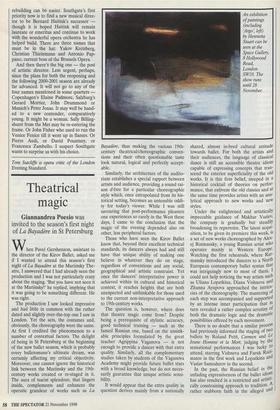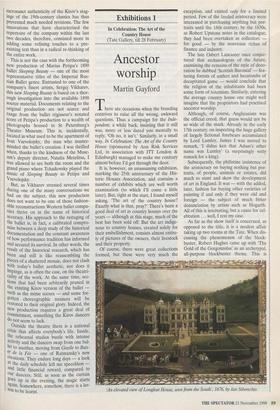Theatrical magic
Giannandrea Poesio was invited to the season's first night of La Bayadere in St Petersburg When Pavel Gershenzon, assistant to the director of the Kirov Ballet, asked me if I wanted to attend this season's first night of La Bayadere at the Mariinsky The- atre, I answered that I had already seen the production and I was not particularly crazy about the staging. 'But you have not seen it at the Mariinsky!' he replied, implying that it was going to be something different. He was right.
The production I saw looked impressive and had little in common with the rather dated and slightly over-the-top one I saw in London. Yet the sets, the costumes and, obviously, the choreography were the same. At first I credited the phenomenon to a number of contextual factors. The delight of being in St Petersburg at the beginning of the new ballet season, which is probably every balletomane's ultimate dream, was certainly affecting my critical objectivity. Moreover, one cannot ignore the historical link between the Mariinsky and the 19th- century works created or re-staged in it. The aura of tsarist splendour, that lingers inside, complements and enhances the operatic grandeur of works such as La An exhibition of paintings (including Argo, left) by Henrietta Stuart can be seen at the Space Gallery, 8 Hollywood Road, London SW10. The show runs until 28 November.
Bayadere, thus making the various 19th- century theatrical/choreographic conven- tions and their often questionable taste look natural, logical and perfectly accept- able.
Similarly, the architecture of the audito- rium establishes a special rapport between artists and audience, providing a sound rai- son d'être for a particular choreographic style which, once extrapolated from its his- torical setting, becomes an untenable oddi- ty for today's viewer. While I was still savouring that post-performance pleasure one experiences so rarely in the West these days, I came to the conclusion that the magic of the evening depended also on other, less peripheral factors.
Those who have seen the Kirov Ballet know that, beyond their excellent technical standards, its dancers always had and still have that unique ability of making one believe in whatever they do on stage, regardless of conventions and any social, geographical and artistic constraint. Yet once the dancers' interpretative power is achieved within its cultural and historical context, it reaches heights that are both unexpected and unthinkable for those used to the current non-interpretative approach to 19th-century works.
The question is, however, where does that theatre magic come from? Despite being a prerequisite of stylistic accuracy, good technical training — such as the famed Russian one, based on the unsink- able principles formulated by the great teacher Agrippina Vaganova — is not enough to provide a dancer with that extra quality. Similarly, all the complementary studies taken by students of the Vaganova Academy might provide future ballet stars with a broad knowledge, but do not neces- sarily guarantee that unique artistic sensi- bility.
It would appear that the extra quality in question derives mainly from a nationally shared, almost in-bred cultural attitude towards ballet. For both the artists and their audiences, the language of classical dance is still an accessible theatre idiom capable of expressing concepts that tran- scend the exterior superficiality of the old works. It is this firm belief, steeped in a historical cocktail of theories on perfor- mance, that enlivens the old classics and at the same time provides artists with an ana- lytical approach to new works and new styles. Under the enlightened and artistically impeccable guidance of Makhar Vaziev, the company is gradually but steadily broadening its repertoire. The latest acqui- sition, to be given its premiere this week, is a set of new works choreographed by Alex- ej Ratmansky, a young Russian artist who operates mainly in Western Europe. Watching the first rehearsals, where Rat- mansky introduced the dancers to a North European contemporary ballet syntax that was intriguingly new to most of them, I could not help noticing the way artists such as Uliana Lopatkina, Diana Vishneva and Zhanna Ayupova approached the intrica- cies of the choreography. The mastering of each step was accompanied and supported by an intense inner participation that in turn revealed a rather complex scrutiny of both the dramatic logic and the dramatic possibilities offered by each movement. There is no doubt that a similar process had previously informed the staging of two ballets by Roland Petit, Carmen and Le Jeune Homme et la Mort, judging by the sensational performances I was lucky to attend, starring Vishneva and Faruk Ruzl- matov in the first work and Lopatkina and Vaslav Samodurov in the second.
In the past, the Russian belief in the unfading expressiveness of the ballet idiora has also resulted in a restricted and artisti- cally constraining approach to tradition. A rather stubborn faith in the alleged and sacrosanct authenticity of the Kirov's stag- ings of the 19th-century classics has thus prevented much needed revisions. The few innovations that have characterised the repertoire of the company within the last two decades, therefore, consisted more in adding some refining touches to a pre- existing text than in a radical re-thinking of the entire work.
This is not the case with the forthcoming new production of Marius Petipa's 1890 ballet Sleeping Beauty — one of the most representative titles of the Imperial Rus- sian Ballet genre. Entrusted to one of the Company's finest artists, Sergej Vikharev, this new Sleeping Beauty is based on a thor- ough investigation into the available 1890 source material. Documents relating to the original production are not scarce and range from the ballet regisseur's notated score of Petipa's production to a wealth of photographs housed in St Petersburg's Theatre Museum. This is, incidentally, located in what used to be the apartment of Ivan Vsevolojsky, the man who master- minded the ballet's creation. I was thrilled when, thanks to the kindness of the Muse- um's deputy director, Natalia Metelitsa, I was allowed to see both the room and the grand piano where Tchaikovsky played the music of Sleeping Beauty to Petipa and Vsevolojsky. But, as Vikharev stressed several times during one of the many conversations we had on the subject, this new production does not want to be one of those fashion- able reconstructions Western ballet compa- nies thrive on in the name of historical accuracy. His approach to the restaging of the ballet is, in fact, a calibrated compro- mise between a deep study of the historical documentation and the constant awareness of how performance tradition has informed and secured its survival. In other words, the result of the historical research, which has been and still is like reassembling the pieces of a shattered mosaic, does not clash with today's ballet aesthetic, nor does it lnipinge, as is often the case, on the theatri- cality of the work. At the same time, sec- tions that had been arbitrarily pruned in the existing Kirov version of the ballet such as the mime scenes — and some for- gotten choreographic nuances will be restored to their original glory. Indeed, the new production requires a great deal of Commitment, something the Kirov dancers do not seem to lack.
Outside the theatre there is a national crisis that affects everybody's life. Inside, the rehearsal studios bustle with intense activity and the dancers swap from one bal- let to another, moving from Giselle to Bals- er de la Fee — one of Ratmansky's new creations. They endure long days — a look at the daily schedule left me speechless — arid little financial reward, compared to Our dancers. Still, as soon as the curtain goes up in the evening, the magic starts again. Somewhere, somehow, there is a les- son to be learnt.



















































































 Previous page
Previous page